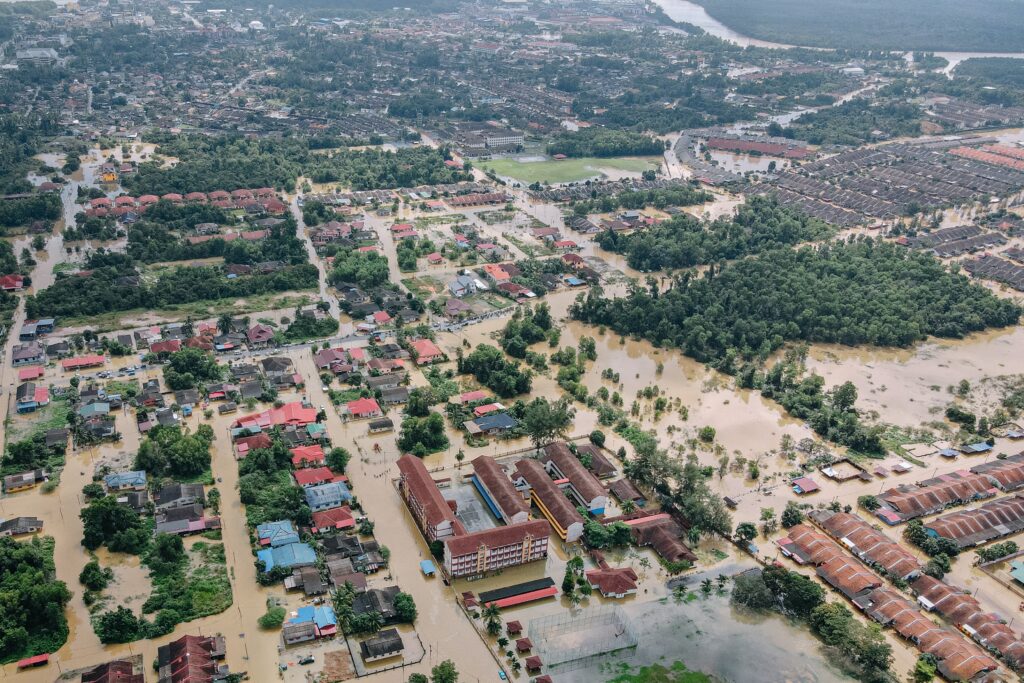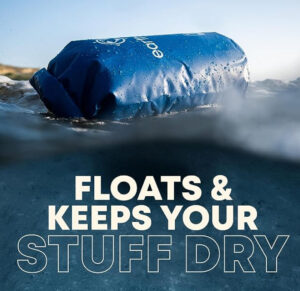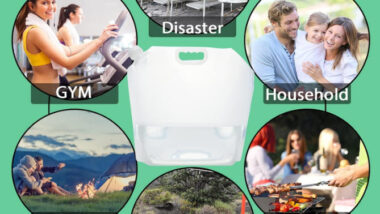Tips for Safely Navigating Flood Areas

Navigating through flooded areas is challenging and can be a perilous journey. But there are times when you need to escape a location due to a crisis or natural disaster.
As water levels rise and unexpected hazards lurk beneath the surface, you must approach the situations with caution and preparation. In this article, you will find comprehensive tips and advice to enhance your understanding how to better navigate water during emergencies.With a firm grasp on these strategies, you can reduce the risk and ensure a smoother journey through floodwaters in an emergency situation.
Prepare before you enter flooded areas
Before venturing into flooded areas, it is crucial to gather as much information as possible about the situation at hand. Consult local authorities, emergency management agencies, and weather forecast reports to obtain accurate and up-to-date information. This will give you a better understanding of the scope and severity of the flooding, as well as any potential risks or hazards that may be present in the area.
Check weather alerts for flood warnings
Stay informed about weather conditions by regularly checking weather alerts and updates. Floods can be unpredictable, and weather forecasts can provide valuable insights into how the situation may evolve. Pay attention to rainfall amounts, potential flash flooding, and any warnings or advisories issued by meteorological agencies. Being aware of weather alerts will help you make informed decisions and stay safe while navigating through flooded areas.
Assess the severity of water and flooding
Evaluate the severity of the flooding before entering any affected areas. Determine the depth of the water and the speed of the current. This will help you assess the level of risk involved and choose the most appropriate course of action. Remember that even shallow water can pose a danger, especially if there are hidden hazards beneath the surface. Always prioritize your safety and exercise caution when dealing with any level of flooding.
Inform others about your plans to evacuate
Before entering a flooded area, make sure to inform someone you trust about your plans. Let them know where you are going and when you expect to return. Share the gathered information about the flooding and your intended route. This way, if something goes wrong or you encounter an unexpected situation, someone will be aware of your whereabouts and can take appropriate action if needed. It is always wise to have a safety net in place, especially when navigating through potentially hazardous conditions.
Use proper gear and equipment

Buy the Best Selling Waterproof Bag on Amazon!
When entering flooded areas, it is essential to wear appropriate clothing that provides adequate protection. Choose durable, water-resistant materials that can withstand the challenges of navigating through water.
Opt for long-sleeved shirts and long pants to minimize the risk of cuts, scrapes, and exposure to contaminated water. Additionally, wear sturdy, supportive footwear with good traction to help prevent slips and falls. And if you have one pack a compact life jacket in your go bag.
Use protective equipment
In certain situations, it may be necessary to use protective equipment to ensure your safety in flooded areas. Depending on the circumstances, consider wearing a personal flotation device (PFD) to help you stay afloat in case of strong currents. Safety goggles can protect your eyes from debris or contaminants in the water. Moreover, using gloves and a face mask can provide an extra layer of protection against potential hazards and waterborne diseases.
Carry essential supplies (including lifejackets)
Before entering flooded areas, pack a waterproof bag with essential supplies that can aid in emergencies. This may include a flashlight with spare batteries, a whistle to attract attention if needed, a multi-tool, a portable first aid kit, non-perishable food items, and bottled water. It is also advisable to carry a fully charged mobile phone, a map or compass, and any necessary medication. By being prepared and having essential supplies readily available, you can increase your chances of staying safe and self-sufficient during the navigation of flooded areas.
Evaluate the risk -determine water depth and current
Before entering any flooded area, it is important to assess the depth and current of the water. Use a sturdy stick or a pole to probe the water in front of you and measure its depth. Pay attention to the speed and strength of the currents, as they can make it difficult to maintain your balance and navigate safely. As a general rule, avoid attempting to cross water that is deeper than knee height and has a strong current, as it poses a higher risk of being swept away.
Checking for hidden hazards
In flooded areas, there may be hidden hazards beneath the water’s surface that can cause injury or entrapment. Be cautious of submerged objects, such as debris, rocks, or tree branches, that may not be visible from above. These can pose a significant risk if stepped on or encountered while navigating through the water. Regularly scan the area around you and use your probing stick to check for any potential obstructions before taking each step.
Assess structural integrity
When navigating through flooded areas, it is important to evaluate the structural integrity of any bridges, walkways, or other elevated structures you may encounter. Floodwaters can weaken structures and make them unstable or prone to collapse. Look for signs of damage, such as sagging or cracks, and avoid crossing if there is any doubt about their stability. Your safety should always be the top priority, so choose alternative routes if necessary.
Understand the water source
Understanding the source of the floodwater can provide valuable information about potential contaminants and health risks. Floodwaters can be contaminated with sewage, chemicals, or other hazardous substances. Avoid contact with the water as much as possible and refrain from drinking it.
If you have any open wounds or injuries, take extra precautions to avoid exposing them to the floodwater. Treating any open wounds promptly can help prevent infection and minimize potential health risks.
Choose the safest route
Identifying high ground areas
When navigating through flooded areas, your goal should be to reach high ground whenever possible. Elevated areas are less likely to be affected by flooding and can provide a safe haven. Identify high ground, such as hills or buildings on higher terrain, and plan your route accordingly. Avoid low-lying areas, as they are more susceptible to flooding and may present greater risks.
Avoiding fast-flowing water
Fast-flowing water can be extremely dangerous and pose a significant risk of being swept away. Avoid crossing or wading through water that is moving swiftly, as even a relatively shallow stream can exert a powerful force. Look for alternative routes or wait for the water to subside before proceeding. Your safety is paramount, so exercise caution and make decisions based on avoiding fast-flowing water.
Staying away from downed power lines
In flooded areas, downed power lines may be hidden beneath the water’s surface. These lines can carry live electrical currents and pose a severe danger. Never approach or touch a downed power line, even if it appears to be inactive. Exercise extreme caution and maintain a safe distance. If you encounter a downed power line, report it to the appropriate authorities immediately and choose an alternate route if necessary.
Water navigation techniques
When walking in flooded areas, it is important to proceed with caution and maintain a firm footing. Take small, deliberate steps and avoid rushing. Test the stability of the ground beneath the water with your probing stick before fully committing your weight. Be mindful of changes in water depth and the presence of any hidden hazards. By walking with caution, you can reduce the risk of slips, falls, or injuries.
Using a sturdy stick for probing
Using a sturdy stick or pole can greatly assist in navigating through flooded areas. The stick serves as a probing tool to check the depth of the water in front of you and detect any hidden obstacles or uneven terrain. It provides stability and a point of contact with the ground, allowing you to gauge the stability before taking your next step. Always use a stick that is strong enough to support your weight and has a comfortable grip.
Creating a human chain for stability
In situations where the water is particularly deep or the current is strong, creating a human chain with others can provide added stability and safety. Form a line by holding onto each other’s arms or shoulders, with the strongest and most experienced person leading the way. This technique helps distribute weight and provides support, making it easier to navigate through challenging conditions. Remember to communicate effectively and maintain a firm grip to ensure the chain remains intact.
Dealing with strong currents – Swimming against the current
In instances where you find yourself in a strong current, it is essential to know how to swim against it effectively. Swim diagonally or at an angle towards the shore, rather than trying to swim directly against the current. This approach helps conserve energy and makes it easier to withstand the force of the water. Avoid panicking and remain calm, as it is crucial to conserve your strength while swimming against a strong current.
Floating with your feet pointing downstream
If swimming against the current becomes too difficult, then floating with your feet pointing downstream can be a safer option. This technique allows you to conserve energy and maintain better control in fast-moving water.
Technique for floating down stream
Lie on your back, keep your head above water, and point your feet towards the direction of the current. By doing so, you can navigate any obstacles more easily while waiting for assistance or reaching a safer area.
Observe debris when navigating flooded areas
It is important to maintain situational awareness and be vigilant for any obstacles or debris that may pose a threat in strong currents. Look ahead and anticipate any incoming hazards, such as tree trunks, large branches, or other floating objects. If possible, steer clear of these obstacles by adjusting your position in the water or swimming around them. Always prioritize your safety and avoid unnecessary risks when dealing with strong currents.
Avoid contaminated flood water
Being aware of potential health risks
Floodwater can be heavily contaminated with various substances, including sewage, chemicals, and other pollutants. These contaminants can pose significant health risks, such as bacterial infections, skin irritations, or diseases. Be aware of the potential dangers and take precautions to avoid contact with the water as much as possible. By understanding the risks, you can take appropriate measures to protect your health and well-being.
Avoiding contact with the water
Minimize your exposure to contaminated flood water by avoiding direct contact. Refrain from walking or wading through the water unless absolutely necessary. If you need to cross a flooded area, use the water navigation techniques mentioned earlier to mitigate contact as much as possible. Always prioritize your safety and be cautious of potential health hazards associated with contaminated floodwater.
Treat any open wounds
If you have any open wounds or cuts, it is essential to take extra precautions when navigating through flooded areas. Keep the wounds clean and covered to reduce the risk of infection. Use waterproof bandages or dressings to protect the wounds from contact with potentially contaminated water. After safely leaving the flooded area, clean the wounds thoroughly with clean water and apply antiseptic ointment. Seeking medical attention as soon as possible is recommended to prevent any complications.
Looking out for wildlife when navigating flood waters
Beware of snakes and other dangerous animals
Flooded areas may attract wildlife that is displaced from their natural habitats due to rising water levels. Be cautious and aware of the presence of dangerous animals, particularly snakes. Snakes may seek refuge on higher ground, fallen trees, or other objects. Stay alert, watch your surroundings, and avoid provoking or disturbing wildlife. It is best to maintain a safe distance and give animals the space they need.
Avoid disturbing their habitat

Respect the wildlife that you encounter in flooded areas and do not provoke or attempt to handle them. Keep in mind that animals may be stressed, disoriented, or protective of their young in such situations. Maintain a respectful distance and allow them to move freely without interference. By avoiding unnecessary interactions with wildlife, you reduce the risk of injury to both yourself and the animals.
Staying safe inside a vehicle
Avoiding driving through flood waters
One of the most critical rules for staying safe during floods is to avoid driving through floodwaters. It is challenging to accurately assess the depth and strength of the water, and even shallow flooding can quickly overcome a vehicle. Additionally, submerged roads may have hidden hazards that can damage your vehicle or leave you stranded. Turn around and find an alternative route if you encounter standing water on the road.
Exiting a submerged vehicle
If your vehicle becomes submerged in floodwaters, it is crucial to exit it as quickly and safely as possible. Roll down the windows or use a window-breaking tool to escape if the doors are jammed. Do not attempt to open the doors while the vehicle is still submerged, as the pressure differential may make it impossible. Once you are out of the vehicle, swim to the surface and seek higher ground. Remember to prioritize your safety and stay calm in such situations.
Seeking higher ground
In the event that your vehicle becomes stranded or submerged in floodwaters, seek higher ground immediately. Climb onto the roof of the vehicle if it is accessible and stable. Signal for help by waving brightly colored clothing or using a whistle. If higher ground is within reach, make your way there as quickly and safely as possible. Remember that your safety is paramount, and it is crucial to take swift action to protect yourself in these circumstances.
Recognizing signs of danger
Being alert to changing conditions
Always remain vigilant and alert to changing conditions when navigating through flooded areas. Floodwaters can rise rapidly, and unforeseen dangers may arise. Pay attention to any signs of worsening weather or escalating water levels. The environment can be unpredictable, and being aware of your surroundings will help you make informed decisions and take appropriate actions to ensure your safety.
Listening for emergency broadcasts
Stay tuned to emergency broadcast channels or local news stations for updates and instructions. Radio or other communication devices can often provide valuable information during flooding situations. Emergency alerts or warnings may convey essential information about evacuation routes, road closures, or other hazards to be aware of. By actively listening for broadcasts, you can stay informed and adapt your plans accordingly.
Concluding How to Navigate Flood Areas in an Emergency
If at any point you feel that your safety is compromised or the situation becomes too challenging to handle on your own, do not hesitate to seek immediate help. Contact emergency services or local authorities for assistance. It is better to ask for help than to put yourself in unnecessary danger. Trust your instincts and prioritize your well-being above all else.



